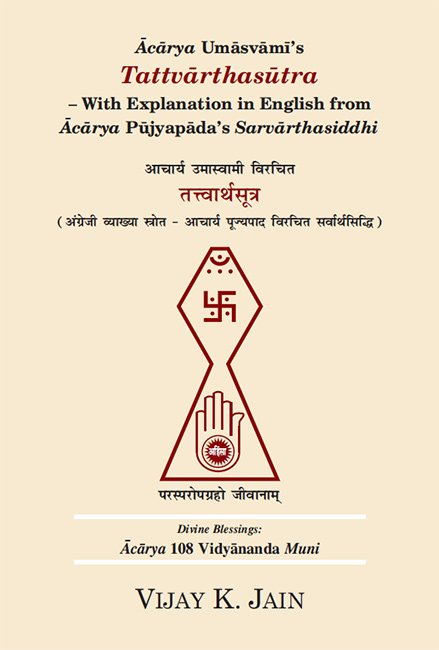Tattvartha Sutra (with commentary)
by Vijay K. Jain | 2018 | 130,587 words | ISBN-10: 8193272625 | ISBN-13: 9788193272626
This page describes the six kinds of external austerities (bahya-tapas) which is verse 9.19 of the English translation of the Tattvartha Sutra which represents the essentials of Jainism and Jain dharma and deals with the basics on Karma, Cosmology, Ethics, Celestial beings and Liberation. The Tattvarthasutra is authorative among both Digambara and Shvetambara. This is verse 19 of the chapter Stoppage and Shedding of Karmas and includes an extensive commentary.
Verse 9.19 - The six kinds of external austerities (bāhya-tapas)
Sanskrit text, Unicode transliteration and English translation of Tattvartha sūtra 9.19:
अनशनावमौदर्यवृत्तिपरिसंख्यानरसपरित्यागविविक्तशय्यासनकायक्लेशा बाह्यं तपः ॥ ९.१९ ॥
anaśanāvamaudaryavṛttiparisaṃkhyānarasaparityāgaviviktaśayyāsanakāyakleśā bāhyaṃ tapaḥ || 9.19 ||
The six kinds of external (bāhya) austerities (tapa) are fasting–anaśana, reduced diet–avamaudarya, special restrictions for begging food–vṛttiparisaṃkhyāna, giving up stimulating and delicious food–rasaparityāga, lonely habitation–viviktaśayyāsana, and mortification of the body–kāyakleśa. (19)
Hindi Anvayarth:
अन्वयार्थ: [अनशनावमौदर्यवृत्तिपरिसंख्यानरसपरित्यागविविक्तशय्यासनकायक्लेशा] सम्यक् प्रकार से अनशन, सम्यक् अवमौदर्य, सम्यक् वृत्तिपरिसंख्यान, सम्यक् रसपरित्याग, सम्यक् विविक्तशय्यासन और सम्यक् कायक्लेश-ये [बाह्यं तपः] छः प्रकार के बाह्य तप हैं।
Anvayartha: [anashanavamaudaryavrittiparisamkhyanarasaparityagaviviktashayyasanakayaklesha] samyak prakara se anashana, samyak avamaudarya, samyak vrittiparisamkhyana, samyak rasaparityaga, samyak viviktashayyasana aura samyak kayaklesha-ye [bahyam tapah] chah prakara ke bahya tapa haim |
Explanation in English from Ācārya Pūjyapāda’s Sarvārthasiddhi:
Conduct (cāritra) has been described. The sūtra next to the one describing the causes of stoppage (saṃvara) mentions austerity (tapa [tapas]). Now austerity (tapa) must be described. It is of two kinds, external (bāhya) and internal (ābhyantara). Each is of six subdivisions. The external (bāhya) austerities are mentioned first.
The external austerity (tapa [tapas]) of fasting–anaśana–is intended to promote self-control (saṃyama) and discipline, destroy attachment (rāga) and karmas, and attain excellent meditation (dhyāna) and scriptural knowledge. It is not done for temporal benefits. Reduced diet–avamaudarya–is intended to develop vigilance in self-control (saṃyama), suppress evils, contentment, and study with ease. Special restrictions for begging food–vṛttiparisaṃkhyāna–consist in limiting the number of houses, etc., for begging food, and these are intended for overcoming desire. The fourth is giving up stimulating and delicious food–rasaparityāga–such as ghee (clarified butter). It is intended to curb excitement caused by the senses, overcome sleep, and facilitate study. The ascetic has to make his abode in lonely places or houses, which are free from insect afflictions, in order to maintain, without disturbance, celibacy, study, meditation, and so on. This is the fifth austerity of lonely habitation–viviktaśayyāsana. Standing in the sun, dwelling under trees, sleeping in an open place without roof, adopting various kinds of postures–all these constitute the sixth austerity, namely, mortification of the body–kāyakleśa.
What is the object of this? The object of this is to cultivate patient endurance of bodily pain and suffering in order to remove attachment to pleasures and to proclaim the glory of the teachings of Lord Jina. What is the difference between affliction (parīṣaha) and mortification (kāyakleśa)? Affliction is what occurs by chance. Mortification is self-imposed. Why is this called external? This is called an external austerity (tapa) because it depends on external environment and is seen by others.
